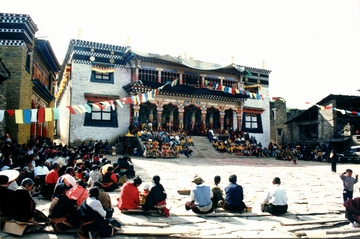

 |
 |
|
| |
|
The History Dhe-Tsang Monastery was built in 1414 by
Tsako Ngawang Drakpa, a close disciple of the 15th century great master Je Tsong Khapa. The monastery is situated in the Gyalrong district of eastern Tibet, or in a modern day's map, the Abba Tibetan Autonomous County of the Sichuan Province of China. It is 504 kilometers from Sichuan's capital, Chengdu.
| |
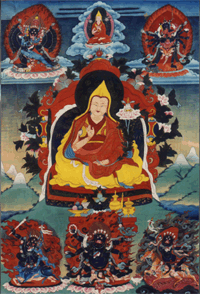 |
Tsako Ngawang Drakpa, founding abbot of Dhe-Tsang & a heart disciple of Lama Tsong Khapa. |
|
The monastery was built at the hub of a naturally formed mandala of the 13-deity Yamantaka, a holy place. When its founder, Tsako Ngawang Drakpa, came to the region while on a mission of building 108 monasteries, he felt the place was special but could not decide on the best exact location to build the monastery. At that moment, a huge crow flew down and took his khadak (scarf) and flew away towards the direction of the site where Dhe-Tsang Monastery was eventually built on. Following the crow, Ngawang Drakpa found the khadak hanging on a large Juniper tree amidst the forest. At the bottom of this tree, there was a nest of ants. Ngawang Drakpa felt that it was auspicious and that it meant the monastery, if built on this site, would eventually grew to be a monastic complex with a large number of monks, as symbolized by the large number of ants living around the Juniper tree. As the tree was chosen by the crow, which was regarded as an emanation of the protector Mahakala (who was to become Dhe-Tsang Monastery's uncommon protector), instead of cutting down the tree, Ngawang Drakpa trimmed its branches and built the grand prayer hall around it. The living tree thus became one of the grand pillars of the hall. | |
 |
The original pillar of Dhe-Tsang, now preserved. |
|
In the process of building the monastery, Ngawang Drakpa faced many obstacles caused by the local Bonpo masters, who were opponents of the building of such Buddhist monastery in their region. Whatever was built during the day would collapse during the night, due to the power of the Bonpo's black magic. One time when Ngawang Drakpa was contemplating on the problem, the crow appeared to him again. By this time, it was clear that the crow was an emanation of Mahakala. Thus Ngawang Drakpa wrote a letter seeking his master's advice and gave it the crow. The crow flew to Lhasa, a distance of a 6-month journey on foot and arrived in front of Je Tsong Khapa when he was making a landlord offering on a hill one day. The great master then composed a powerful practice known as 'the Solitary Hero Vajra Bhairava Sadhana' and gave it to the crow to deliver to Ngawang Drakpa. When the latter received the practice manual, he performed the ritual
intensively and subdued all of the 34 leading Bonpo masters in one night.
The text later became one of the most important texts used in all Gelugpa
monasteries up till the modern day. In the colophon of this famous text,
Tsong Khapa said that the text was composed
especially for 'Dhe-Tsang Monastery, situated in the distant forest of
the east'. Dhe-Tsang Monastery used to be the custodian of the original
copy but it was taken away to be kept in another monastery sometime around
the end of the 18th century. | |
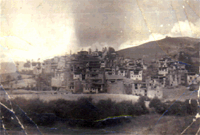 |
Photo of the historical Dhe-Tsang Monastery, taken in the 1960's before its destruction. |
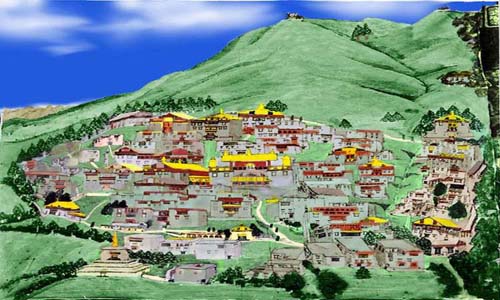 |
An old painting done by a Dhe-Tsang monk in 1957 of the monastery. |
|
By 1414, Ngawang Drakpa had constructed 8 buildings, including the protector chamber, which was the only building that survived more or less in its original state up till today. At this time, Ngawang Drakpa needed the service of master sculptors to build statues for the monastery. One day, 3 black men visited the monastery site and were invited to stay there for a while. The black men claimed to be master sculptors coming from India. Delighted, Ngawang Drakpa eagerly invited them to help build the statues. Of the 3 men, only 1 agreed to stay and help. He built all the statues as requested except for the Mahakala statue, which was only half completed when it came to the time of official opening. During the celebration, there were some ritual dances. At the end, the Indian announced that he would also like to perform a dance for the entertainment of the viewers and proceeded to make a swirling dance wearing a large protector mask. Towards the end of the dance, his body became smaller and smaller and at the end the mask dropped and there was no trace of the dancer. The monks thought that perhaps the Indian was an emanation of a holy being and rushed to see the Mahakala statue. It was found that the statue was completed. The monks realized the Indian sculptor was none other than Mahakala himself, who came to help build the monastery and the statues. The Mahakala statue became a very special statue as it was believed that the Indian merged into the half completed statue to make it complete. Later on, the monks found that the other 2 Indians who did not agree to stay at Dhe-Tsang had gone to 2 other monasteries and each made a Mahakala statue and they too mysteriously disappeared into the statues. The statues made by these 2 were the 4-armed form of Mahakala and the White Mahakala. Thus these 2 statues and the 6-armed Mahakala at Dhe-Tsang became known as the '3 Mahakala Brothers' and became most famous in the region. Throughout the history, pilgrims came from as far as Amdo, Mongolia, Wutaisan and Central Tibet to pay homage to these 3 special statues. While most other Tibetan monasteries also host statues of the same protector, he is regarded as a 'real' member of the sangha at Dhe-Tsang. During each offering ceremony, the chant leader would say aloud, ' Do not forget the black man's share!' and the same of what each monk receives would be offered in front of the Mahakala statue. This uncommon tradition came about as the Indian sculptor, when building the statues, once said that he demand nothing special but only that he be given the same of what each monk would get. When counting the number of residents at Dhe-Tsang, the protector is always counted as a member. These traditions have been followed since 1414 and are uncommon to other Tibetan monasteries. In the famous history text 'Political and Religious History of the Amdo regions', this story has been cited. Dhe-Tsang Monastery was so named, according to legends, by Ngawang Drakpa as it was the last of the 108 monasteries which he promised to build in front of his master, Je Tsong Khapa. The name literally means 'fulfillment' or 'completion'. One local belief maintains that Ngawang Drakpa did not actually name the monastery 'Dhe-Tsang' but that at the opening ceremony, the master sighed in relief 'Dhe-Tsang', as the opening of it marked the fulfillment of his promise. The name became known widely and thus was adopted as the official name of the monastery by either Tsong Khapa or Ngawang Drakpa later. The full official name given by Tsong Khapa for the monastery is 'Gadan Dhe-Tsang Lhundrup Ling'. The monastery was completed in 1414, only 5 years after the founding of the Gadan, the first monastery of Je Tsong Khapa's Gelug tradition, and thus was also called the '2nd Monastery'. It is established that Ngawang Drakpa built 108 monasteries, Dhe-Tsang being the last (which was why it was so named) and that most, if not all, of the 108 were built after the founding of Gadan (It is likely that all of them were built after the founding of Gadan, as Ngawang Drakpa seem to have left Lhasa to start his mission after the founding of Gadan, in 1409) and before any other Gelugpa monasteries. Modern day historians do not know the reason of Dhe-Tsang being commonly regarded as the '2nd oldest monastery' of the Gelugpa lineage. Some suggested the possible explanation that Dhe-Tsang was the only one out of the 108 which could be called a monastery with full education and spiritual facilities rather than small temples. Ngawang Drakpa served as the 1st abbot
of the monastery and his disciple Choje Drakpa, also an eminent lama who
studied under Tsong Khapa, served as the 2nd
abbot. Since then, the successive Khejok Tulkus
and Jamkhang Tulkus have held the positions of supreme authority of the
monastery. Eminent lamas such as Gungtang Rinpoche and Jamuyang Rinpoche
have also served as abbots of Dhe-Tsang at some point in history. | |
 |
His Eminence Khejok Rinpoche |
|
At its peak, Dhe-Tsang Monastery had 108 buildings and 850 monks resident. The monastic complex was built in a dense forest of Juniper trees which was inhabited by bears, deers, tigers and many other forms of wildlife. There were 3 large chapels housing large Maitreya statues, a grand prayer hall, a protector chamber and smaller chapel. Near the entrance of the monastic complex, there was a stupa which stood 90 feet tall. Just behind the monastery, up the small hill, there was a hermitage used by many great masters. In the each of the monks quarters, there were murals depicting Sakyamuni and Tsong Khapa's lives and sets of the collected works of woodblock-printed Buddhist texts. Numerous gifts such as seals, letters, rare statues, paintings and brocade woven with gold strings were preserved in the monastic museum. In terms of religious relics, the monastery housed a tooth of Lama Tsong Khapa and relics of many great masters including that of the first 7 Gadan Tripas, successive throne holders of the Gadan or Gelugpa tradition. A full curriculum of Buddhist education on the sutras and tantras was taught at the monastery and a calendar of intensive religious practices was followed. The 6th Dalai Lama visited the monastery once and stayed there in retreat for weeks. A stone tablet was erected in memory of his visit and His Holiness mentioned his stay and sang praises of the monastery in his writings. | |
 |
Calligraphy,written on a wall,related to the historical visit of the 6th Dalai Lama to the monastery, said to be written by the 6th Dalai Lama himself. |
|
The Prophecy and the destruction At one time during the golden era of the monastery, a great master in the name
of Kawachu Losang Nyingma Geshe made a prophecy, doubted by people of
his time, that the monastery would one day be destroyed, people from very
distant lands would rebuild it, the grand prayer hall would be even bigger
than before and there would be a debate court which did not exist at the
time of this master. The monastery had a gong which was known for its
loud sound. The master further prophesized 'After the rebuilding, the
population of monks would be so big that their living quarters would be
built all over the valley and even the loud sound of our famous gong now
used to summon monks would not be able to reach the distant monks quarters.
Two loud gongs would have to be used to summon monks for services and
a large number of Chinese monks would be debating alongside Tibetans in
the debate training court.' In the 1950's, the monastery was completely
destroyed in political movements. Monks were forced to disrobe. Statues
and texts were destroyed. Most of the buildings were demolished except
for the Mahakala chamber, one of the original buildings constructed by
Ngawang Drakpa. The forest has been
completely logged. The monastery was left in ruins for almost 30 years.
| |
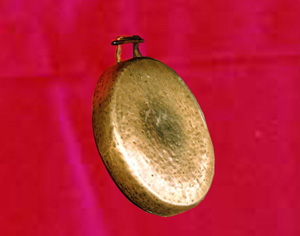 |
The Ming dynasty gong of Dhe-Tsang, presented by a Chinese general in the 15th century and famous for its loud and beautiful sound. This gong was mentioned in an ancient prophecy about the monastery. |
|
Fulfilling the prophecy In 1983, monks started to return to the monastery and rebuild with limited
funds. In 1993, His Eminence Khejok Rinpoche
visited the monastery after almost 40 years of absence and his disciples
from many countries started to help both financially and physically
in
its restoration. By 1997, the grand prayer hall has been rebuilt and
is almost twice bigger than the old hall, with over 3,000 bronze statues
and numerous fine paintings lining its walls (murals and the interior
of the grand prayer hall could be viewed in this site's cyber
tour around the monastery ).
A debating training courtyard has been built. Monks quarters, classrooms,
kitchens and necessary facilities designed for a capacity of 300 student-monks
have been built. A 40 feet tall Maitreya statue, a 25 feet Tsong Khapa
statue, a 15 feet 1000-armed Chenrezig statue and a 10 feet Buddha statue
have been made with chapels to house them. A new pilgrims' trail with
over 1,000 prayer wheels has been completed. 170 friends from 15 countries
joined in the reopening ceremonies of the monastery which took place
in
August 1997. A professionally produced VHS video with English subtitles
recording this auspicious event is available Dhe-Tsang
Monastery Foundation's cyber shop in
this website. Please feel welcome to take a virtual
tour of the monastic complex and the latest restoration progress.
| |
| Video Clip of the Grand Prayer Hall | |
| Video Clip of the Protector Hall | |
| Video Clip of the Maitreya Hall | |
| Video Clip of the Tsong Khapa Hall | |
|
The rebuilding of Dhe-Tsang Monastery is still going on now, with plans to build a 90 feet stupa, schools for Tibetan Medicine, Buddhist paintings and statue-making, guest houses, a monastic museum and a printing press. In the vision of Dhe-Tsang Monastery Foundation and Khejok Rinpoche, the monastery would be able to provide for free the full range training in Buddhist scriptures, meditation, religious arts and Tibetan Medicine to young monks. After graduation, the monks would return to their home towns and monasteries and revive the holy teachings of the Buddha as well as provide free medical services in their native regions. How you can help Please support the restoration of Dhe-Tsang Monastery by (1) Making any purchases at our Cyber Dharmaware shop, run solely by volunteers of the Dhe-Tsang Monastery Foundation with all profits going to the restoration projects, or (2) Becoming a direct sponsor of Dhe-Tsang Monastery of any of the 3 categories. Major Benefactor - Sponsorship of over US$4,880. Each Major Benefactor would receive a beautiful numbered certificate of appreciation and a limited edition of Protector clay pendant in 24K gold plated traditional Tibetan amulet case, each with a relic of the Buddha inserted. The dedication or memorial message composed by or for each Major Benefactor would be engraved on a brass plate and displayed permanently on one of the 42 grand pillars of the Grand Prayer Hall of the monastery. As there are only 42 pillars, this category of sponsorship is limited to 42 Benefactors. Benefactor - Sponsorship of over US$88. The name of Benefactors would be engraved on brass plates and displayed permanently on the walls at the entrance to the Grand Prayer Hall of the monastery. This category of sponsorship is limited to 3,000 Benefactors. General Sponsor - Any amount of sponsorship would be appreciated. Please kindly send your donation by international draft made payable to 'Dhe-Tsang Monastery Foundation' and registered mail to : Dhe-Tsang Monastery Foundation,
With your name, postal and email addresses, a preferred verse of dedication or a memorial message(Major Benefactors) and stating purpose of donation. The Foundation would send you an official receipt immediately and the money would be delivered to the monastery when the Foundation's staff next visit the monastery. Gift of Prayers Monks of the Dhe-Tsang Monastery regularly perform rituals which traditionally include praying for the benefits of sponsors' families and friends. It is possible to have your name or the names of those you care about included in the monastic prayer list(s) by sending in your requests and a donation of any amount. The donation goes to support the monks' education, medical and food expenses. The method of payment is the same as the above sponsorship details (please state clearly that your donation is for the Gift of Prayers). Requests generally fall into the following categories: 1. Health 2. General Well-being 3. Prosperity 4. Progress in Spiritual practices 5. The long life for a loved one You are welcome to contact Dhe-Tsang Monastery Foundation if you would like to solely sponsor specific pujas to be performed. | |